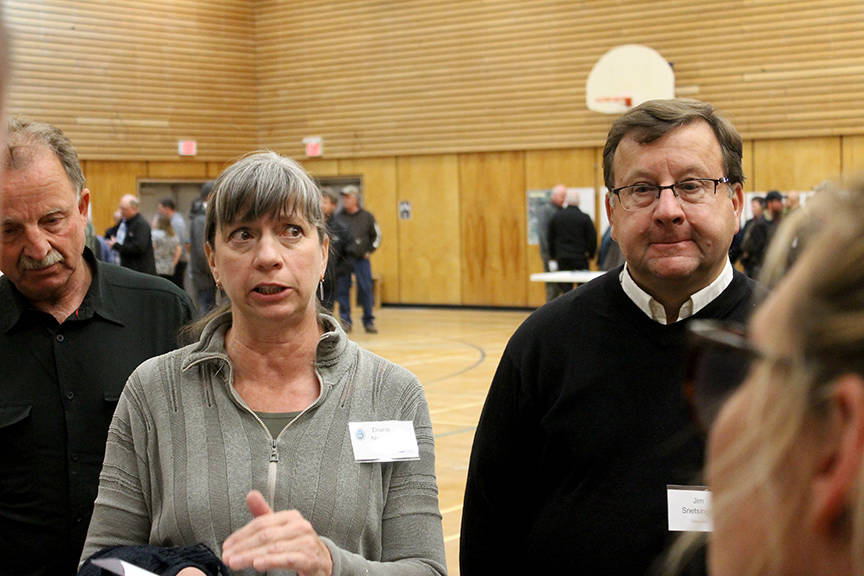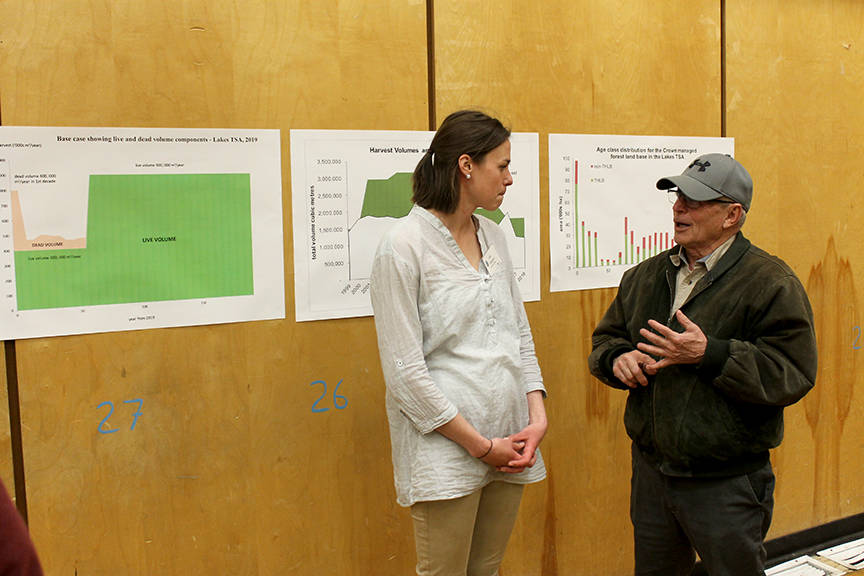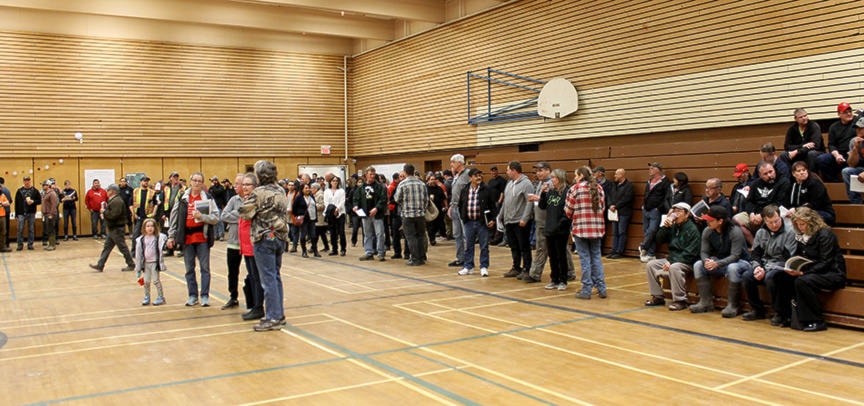Forestry has been top of mind among Burns Lake residents for the past week as the government has started its public comment period on the Lakes Timber Supply Area (TSA).
On April 29 the Ministry of Forests, Lands, Natural Resource Operations and Rural Development (FLNRORD) released its Lakes TSA Timber Supply Analysis Discussion Paper.
It followed that up two days later with an open house in the Gathering Place, where about 200 people came to read information displays and ask questions of officials from FLNRORD.
It was the second year in a row when public discussion of the regional timber supply drew large crowds to the Gathering Place.
LOOK BACK: Large turnout to discuss annual allowable cut in Burns Lake
No sooner was the discussion paper released when rumours began circulating in the village and on social media that the Annual Allowable Cut (AAC) would be reduced by half and lead to numerous job losses among residents working in forestry.
The current AAC, set in 2011 is 1.6 million cubic metres. The Forest Act stipulates that the chief forester has to determine the AAC of the Lakes TSA every 10 years.
Two sentences in the discussion paper summary are the likely source of the rumours: “The base case forecast for the Lakes TSA has an initial harvest level of 400,000 cubic metres of live volume for 60 years” and “While harvesting this live volume, an additional 400,000 cubic metres per year of dead volume can also be salvaged for the next 10 years.”
But that doesn’t mean the AAC will be reduced by half, as Diane Nicholls, the new provincial chief forester told Lakes District News.
”The determination hasn’t been made yet. What we’ve produced is a model that shows - based on the inventory and based on assumptions - this is what it could be,” she said.
Three major factors are behind what is so far looking like a lowered future AAC: changes in tenure and the impacts of Mountain pine beetle and wildfire damage.
Back in 2000, almost all of the harvested timber volume was from volume-based tenures, typically represented by forestry companies. Area-based tenures, such as community forests, First Nations woodlands and woodlots represented a very small part of the harvest.
By 2018 the amount harvested through volume-based tenures had decreased, and the amount from area-based tenures had increased.
“That volume is still there and available for mills to use if they purchase from those licenses but it’s not part of this TSA,” Nicholls said. “There’s a decrease in area size which equates to a decrease in timber available. The timber is still on the land base, it’s just in another place. And accounted for somewhere else.”
The decrease amounts to about 30 per cent (160,000 hectares) after the last timber supply review, and includes lands under the Burns Lake and Chinook community forests and the Lake Babine Nation and Nee Tahi Buhn First Nations woodland licenses.
With the factor of the Mountain pine beetle, it killed about 76 per cent of mature pine trees in the Lakes TSA, or half of the commercially available volume, according to the discussion paper.
“Around the province where mountain pine beetle has hit - AACs are trending downwards. There’s constraints everywhere. It’s difficult for sure,” the chief forester said.
As for the wildfires, 45,000 hectares - 2.8 million cubic metres of mature timber - of the Timber Harvesting Land Base (THLB) in the Lakes TSA were affected by fires in the last few years.
Nicholls pointed out that the effects of a lowered AAC are varied and she didn’t comment on job losses.
“That’s really up to the companies that own the mills and how they behave,” she said.
“[If] I’m a mill person, I look at where I can get my fibre from. I can get it from the licenses that operate on the timber supply area or I can get my fibre from the area-based licenses which are the community forests, the woodlots and the First Nation woodland licenses. And I can purchase wood. If I don’t have timber I can purchase wood and bring it into the mill. I can also purchase wood from outside of this area. And I can take wood from this area and send it to a different mill. Wood can go out and come back in.”
But job losses are a possibility, as Atmo Prasad, Manager of Forest Analysis and Data Management with FLNRORD, told the Regional District of Bulkley-Nechako (RDBN) board of directors meeting on May 2.
“The AAC is coming down and it has the potential to impact jobs. That was the biggest concern we heard last night at [the Gathering Place]. It was well-attended by saw mill employees,” he said, during the presentation to the RDBN along with Nicholls and former chief forester Jim Snetsinger.
Prasad outlined two possible scenarios.
In the first one, the AAC declines to 800,000 cubic metres, of half live timber and half dead. “That would have an impact on jobs and revenue,” he said.
In the second, if dead volume cannot be used, then the AAC falls to 400,000 cubic metres of live volume.
“Then there would be bigger impacts.”
“But remember what Jim said. There are still area-based tenures and they’re contributing 500,000 cubic metres of AAC right now and that wood is still available to the local sawmills and private mills in the area. Wood comes into the TSA from other TSAs and wood goes out and all kinds of trading happens.”
A potential opportunity, and one that could increase short-term harvest levels is to focus more on deciduous stands rather than coniferous.
“Of all the opportunities tested to increase timber supply beyond the base case level, the harvest of the deciduous component of coniferous stands has the largest potential impact,” the discussion paper reads. “Deciduous fibre has been used for the past two and a half years in the production of pellets in the Lakes TSA. The demand for pellets is still growing in Europe and appears to be increasing in Asia.”
Deciduous species like poplar or aspen tend to be used far less in the mills than pine or spruce, but Nicholls said the opportunity is there to use them more, and potentially increase the harvest activity.
Public comments on the timber supply review will be accepted until July 5.
It is expected the final AAC determination will be made by the fall.
Blair McBride
Multimedia reporter
Send Blair an email
Like Lakes District News on Facebook


